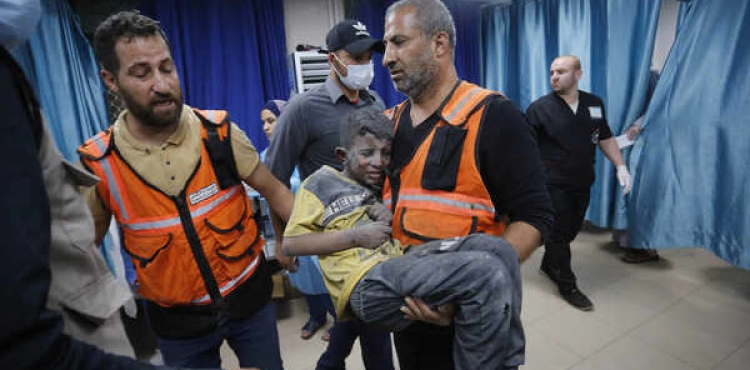Doctors in the Gaza Strip work in complex conditions to treat burn victims, while Israeli air strikes continue in the midst of the most violent Israeli aggression on the Gaza Strip.
The burns department and other departments are filled with patients with various injuries in all the hospitals in the Gaza Strip, which have raised warnings that they will turn into major morgues due to the challenges they face.
In a voice that could barely be heard, a seven-year-old child called out to his mother as he was taken out of the operating room, where he was being treated for burns he sustained as a result of an Israeli bombing that targeted his family’s home in the Al-Nasr neighborhood in central Gaza.
But the child, Wiam Ammar, did not receive a response because all his family members were killed as a result of the bombing.
His cousin, Ahmed Ammar, told Xinhua News Agency, "We have been in the hospital for five days, and Weam has not stopped asking to see his parents, but we have not yet told him the truth."
He added, "Every day, Wiam takes solutions and medicine, but he does not recover, and his psychological condition deteriorates day after day."
The pressure on the medical sector in Gaza is increasing as the influx of casualties from Israeli air strikes continues around the clock since they began on October 7th.
The start of Israel's attack was accompanied by its imposition of a comprehensive closure on the Gaza Strip, and it also cut off all supplies of electricity, fuel, and food to the population.
In a new rescue attempt, Doctor Jamal Al-Assar continues tirelessly cleaning burns and grafting skin in several stages for injured people, many of whom suffer from successive complications that lead to death.
Al-Assar said from inside the intensive care room at Al-Shifa Hospital in Gaza, “Most of the injuries here are the result of burns resulting from bombs that Israel throws at homes, and we have not seen them before, which raised the death rate by 100%.”
He added, "Some cases, numbering in the dozens, are still receiving medical care in the hospital, and some are in urgent need of treatment outside the Gaza Strip."
A number of those injured suffered burns as a result of Israeli attacks that targeted their homes or the neighborhoods in which they live, or while they were trying to rescue other victims who were trapped under the rubble of destroyed homes.
Paramedic Aziz Shamali (42 years old) is preparing to perform the first skin grafting operation after sustaining burns as a result of a bombing that targeted the ambulance he was driving while he and a team of paramedics were trying to save a family in the Shujaiya neighborhood last week.
Shamali said, with his head and his entire body covered with medical bandages, “We received a distress call from Shuja’iya and we headed there, and a few meters before we reached the targeted house, a second bomb fell, wounding me and two of my colleagues.”
An officer in the Hamas Police Explosives Engineering Department, Muhammad Miqdad, said that the ammunition used by the Israeli army was originally manufactured by the United States of America, and is of various sizes and types, including MK82, MK83, and MK84 bombs, in addition to new GPU31 and GPU38 bombs.
Miqdad explained that when these munitions explode, they cause “widespread destruction and the outbreak of fires inside the targeted location.”
Burn injuries, which do not stop in Gaza now, may require months or years to recover, with the provision of specialized health care, which is not available these days, as hospitals are filled with thousands of injured people while medical supplies and consumables are running out.
The first convoys of humanitarian aid trucks entered the Gaza Strip today (Saturday) through the Rafah crossing with Egypt, for the first time since the start of the current round of fighting between Palestinian factions and Israel on the seventh of this month.
The aid includes medical supplies, water, and a limited amount of food, and is at the disposal of the United Nations Relief and Works Agency for Palestine Refugees (UNRWA) and the Palestine Red Crescent Society.
The head of the reception and emergency department at Nasser Medical Complex, Dr. Muhammad Qandil, says that they struggled in the past to obtain the necessary equipment to rehabilitate burn patients, and with the large number, “it has become catastrophic now.”
He added that 70% of the injuries arriving at Nasser Medical Complex include children and women who suffered severe injuries, damage to internal organs, shattered skulls, and burns throughout the body, which requires advanced medical centers.
But Qandil confirms that despite the obstacles and lack of capabilities facing the influx of patients, doctors draw on their expertise from previous war experiences and work to save the largest possible number of injured people.
The total number of Palestinian deaths rose to 4,385 and those injured to 13,561 as Israel's raids on the Gaza Strip continued for the 15th day in a row, according to what the Palestinian Ministry of Health announced today (Saturday).












